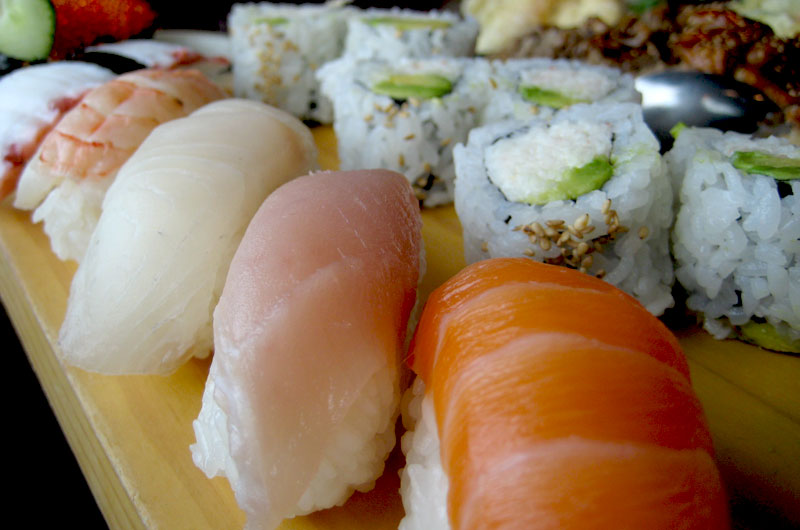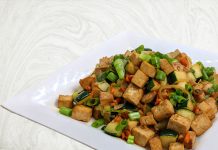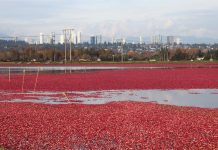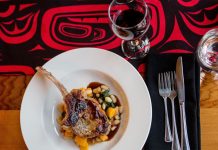Updated: August 29, 2017
Discover Sake and Sushi – The Umami of Nippon. Learn how the people of Shinto country rises from devastation to grab global recognition for their culinary.
Japan is anything but a humdrum country. Disasters may strike the land of bubbling geysers and volcanoes, but the people of Shinto country continues to rise above the power of nature.
Pointing to his oil painting, Thread of Time, Canadian artist, Dominik Modlinski speaks passionately about his journey to a nation- where the people and stunning landscapes inspired him profoundly.
The painting, he says, signifies a link between old and present-day Japan and a society’s determination to survive. The kanji characters denote patience, perseverance and to endure, virtues that are imbued in the Japanese cultural fabric – and mirrored in the making of sake (nihon-shu or sei-shu), Japan’s favoured alcoholic drink.
Sake – The Umami of Nippon
Sake production dates back 2,000 years and is closely tied to the country’s agriculture and Shinto rituals. Brewed from fermented rice, koji (rice malt) and water, the sulphite-free sake is one of the world’s purest beverage and an alternative drink for wine allergy sufferers.
Unlike beer, saccharification and alcoholic fermentation happen concurrently in sake brewing. The process creates an array of complex and delicate aromas and flavours. Fragrance varies from fruity to grassy, caramel to acidic.
Sake contains more amino acids than wine or beer. The Umami (flavour) of sake is influenced by its natural amino acid content, specifically, glutamic acid which boosts the drink’s savouriness.

Japanese sake tasters assessed the liquor based on five flavours – amami (sweetness), karami (dryness), sanmi (acidity), nigami(bitterness), shibumi (astringency).
Sake has a clear to pale yellow (when not treated with active charcoal) appearance.
In Japan, sake is labelled Futsu-shu (ordinary or table sake), and Tokutei meisho-shu (premium sake). There are eight premium varieties including Junmai Daiginjo-shu, Daiginjo-shu and Ginjo-shu.
The liquor quality is defined by its well-balanced flavour. Light and high temperature degrades sake, so it is best stored in dark, cool places. When drunk warm, sake is said to improve chi or energy flow.
The mild flavour of sake pairs well with French, Italian and Chinese cuisines. Rising global demand for sake has also propelled the growth of sake brewery tours to Japan.
Sushi Dreams
Sushi, like sake, is an integral part of the Japanese culinary. The simple dish consists of a bed of cooked vinegared rice topped with a piece of delicately sliced raw seafood.
Related: Curbing Obesity – Hara Hachi Bu Style
Over the past two decades, sushi has become a vogue cuisine for sophisticated diners who travel the globe in search of their favourite sushi.
The Japanese are still the masters when it comes to the art of sushi making – it is more than just fresh ingredients, it about intricacy and precision.

This is portrayed in Jiro Dreams of Sushi, a documentary by filmmaker David Gelb about a three-Michelin-star Master Sushi Chef, Jiro Ono.
At 85, Japanese chef Jiro Ono is regarded to be the world’s greatest sushi chef by culinary experts like Anthony Bourdain, Eric Ripert and Joël Robuchon.
Japan proclaimed him a National Treasure. Ono has been perfecting his sushi skills for 75 years and still retains the Guinness World Record for being the world’s oldest three–Michelin star chef. Customers queue to pay top dollar (cash only) to dine at his tiny 10-seater Tokyo subway sushi bar, Sukiyabashi Jiro.
Tokyo, Japan’s capital continues to hold the crown as the top global gourmet hotspot with the most Michelin-starred restaurants in the world.
Links
A Comprehensive Guide to Sake
Japan Tourism Organisation
Go Tokyo










































